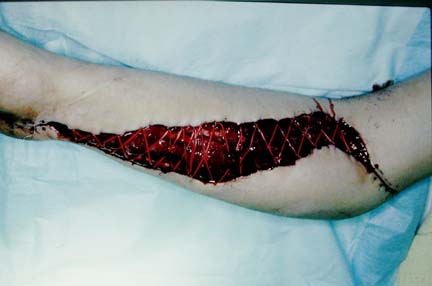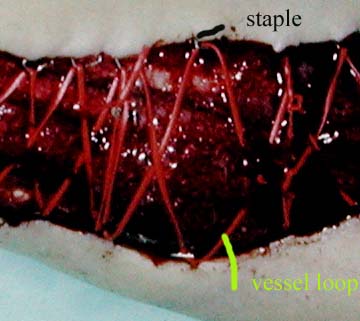![]()
The goal is to prevent the fasciotomy wound edges from separating. Over
time, since the skin has a pull on one side and none on the wound side,
it will always expand. If left for a while, the wound edges cannot be
approximated and skin grafting is necessary.
All of this can be avoided with the vessel loop technique. (After all,
the skin fit before, right?)
This is an overview of the technique.


The middle of the vessel loop (I like this rather than rubber bands or a
red rubber catheter, but anything stretchy works; the key is for it to
be cheap and already in the OR) should be laid over the end of the
wound. Two skin staples are placed over the loop at the very edge of the
skin, one on each side. Cross the ends over to the opposite side and
restaple. Continue until you either run out of wound or run out of
vessel loop. If the latter, just start another loop. At the end of the
wound, tie a knot like a shoe string knot. This allows you later to
untie and tighten up.
Each day, when you do a dressing change, tighten up the loop. The
stretchyness of the vessel loop puts a slight amount of tension (you
control the tension by how hard you pull the loop before tying the knot)
and this both keeps tension on the skin and closes the wound. When the
edges are together, suture.
I have had the case where I did not think I could bring the patient back
to the OR, so I preplaced some sutures, did not tie, and cut off the
needles. On the floor, I tied the sutures slowly and gently, the
patient said it did not hurt, and I was able to close the wound.
When you are done, it is easy to remove the staples at the bedside.
This technique should be better known, as it is effective, safe, cheap
and avoids the myriad problems, both acute and chronic, of a skin graft. However, since it is so cheap, no one makes any money, and no company
is out there promoting it.
One advantage of the above system is that is it very inexpensive and all the parts are currently in your operating room. Other devices available on the market include:
Boehringer Labs Wound Bullet
![]()
Reference
There is an online description here.
![]()
Would you like to search the medical library of the National Library Medicine for scientific papers on this topic? Just click on |
Remember the admonition from the Patient Education Links Page: the Internet has a lot of information, much of it incorrect. I have reviewed the sites that I have linked to, and have only linked to sites when I personally know the surgeon who posted it, or am a member of the organization that posted it. However, I may not agree with all that is on that site, and it may have changed since I reviewed it. If any of the information is not consistent with what I have told you, please download the material and bring it in.
|
|